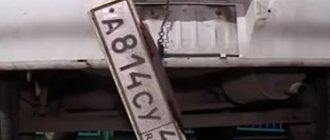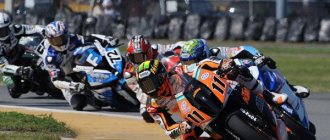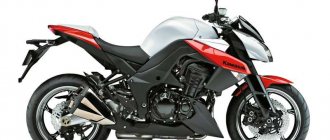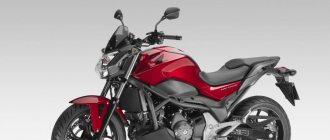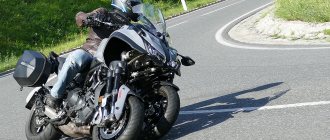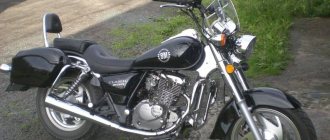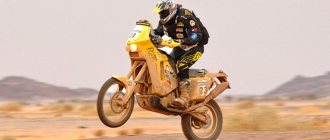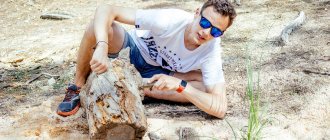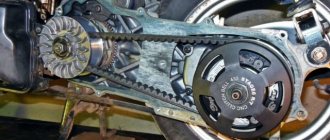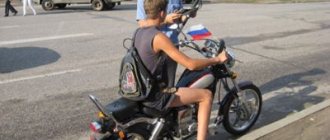Anyone who has ever been to a motocross competition has seen how spectacularly the motorcyclists on their “iron dragons” take corners. Admiring spectators often wonder: is the rider driving the motorcycle or is the motorcycle carrying the rider? In this sport, success equally depends on the skill of the driver, his skills, experience, and the technical characteristics of the vehicle. Only by merging with the motorcycle can an athlete control it, and not everyone can do this. Repeated training develops motor reflexes, which are gradually brought to automaticity.
What is motocross?
First of all, motocross is an exciting sport discipline in which participants compete on special motorcycles. At a distance from public places, a circular route with obstacles in the form of holes, bumps, and turns is selected or specially organized. Driving on such off-road terrain cannot be compared to driving on city asphalt. Various elements (jumps, braking, turns) require muscle coordination, body balance, strength and endurance.
Motocross is not just riding, it is a sport where the task is set and accomplished - to overcome a special section of the track in the shortest possible time. It's dirty, demanding, difficult work, a mixture of excitement, adrenaline and the smell of gasoline.
Motocross Competition Rules
All actions of the organizers and participants must be subject to the Rules and strictly followed.
Requirements for motorcycles
Before each competition, the organizers send participants the Regulations on the event, which specifies the requirements for motorcycle classes:
- category I, group A1: 50-500 cm3 for two-stroke engines, 175-650 cm3 for four-stroke engines;
- category I, group B1, motorized strollers: 2-t – 350-750 cm3, 4-t – working volume up to 1000 cubic meters.
You can compete in several classes. At cups, championships, championships of the Russian Federation, competition in motorized wheelchairs is held only after the performance of singles. Winter racing must be carried out on metal-studded tires. Only one type of tire is used in one race.
Route requirements
The motorcycle racing track is a circular section 1.5-3 km long. It does not bifurcate anywhere; it can be stationary (permanent) or temporary. Official competitions take place on tracks of 1.75 – 2 km. The narrowest point of the route is 6 m, for motorized wheelchairs - no less than 7 m. In the vertical space along the route, nothing should be at a height of less than 3 m. The safety of drivers directly depends on the configuration of the jumps. Multiple jumps are not allowed. After the turns, “ridges” are arranged - mounds half a meter high, the distance between the peaks of which is about 2.5 m. The rules prohibit dangerous routes - with rocky areas, deep reservoirs. Also, there should not be long sections of the journey where you can accelerate to speeds above 55 km/h.
Safety requirements
The organizers are obliged to ensure the safety of all competition participants. The track should be watered before and between runs to reduce dust. There should be no service dogs in the area where racing participants are located.
The entire length of the route must comply with the following rules:
- poles, trees, and other obstacles that cannot be removed are fenced with bales of straw or other material that absorbs impact force;
- a meter-long neutral zone is provided along the entire length; Ideally, this is an embankment 50 cm high with thin wooden pegs driven in, connected together with tape.
The work area (park, start/finish area) must be fenced, and unauthorized persons are prohibited from entering it.
Requirements for the starting area
Starting motorcyclists line up at a distance of a meter from each other. Singles start in groups of 30 people, respectively, the width of the starting zone is at least 30-32 m. If official competitions are held, then 40 people start at the same time. Wheelchair riders are allowed to start in two rows. The starting area is located at right angles to the first turn. Thus, all participants in the race are on equal terms.
Starting car
For a simultaneous start, a starting machine is used. It is controlled from a closed building by a starter manually or remotely. Starters with individual sections that fall down or backward are allowed. This device is installed on a concrete platform 60 cm wide, has a height of 50 cm and an inclination angle of 80⁰. There is 3 m between the barrier and the waiting area, and for motorcycles with a sidecar – 6 m of free space.
What is a racer park and what is it intended for?
A level area intended for the needs of riders must have:
- indoor area for vehicle inspection by a technical commission;
- closed area for parking motorcycles after the race;
- a separately equipped motorcycle wash with normal water flow;
- women's (4) and men's (6) toilets;
- showers (8);
- first aid station;
- fire protection post.
There should also be two training lanes for testing motorcycles, separated by bales or other non-rigid barrier materials. The racers' park must have direct access to the pre-start area. A jury meeting room is located on or near the park.
Other buildings and premises
Around the route there are service points involved in the competition.
- The bureau is right at the entrance to the highway. There are also places for the press. The room is equipped with furniture, telephone, copying equipment, and fax.
- Medical support is specified in the Regulations. There should be 3 ambulances, one of them with resuscitation equipment. The head doctor of the competition and his team are responsible for medical care.
- Fire stations must be located at designated places on the route, as well as in the park, at the start, and in the repair area.
- Commentators broadcast from their posts via loudspeaker.
- There must be a tower to count laps and record time.
- Near the finish line there is a clock showing the race time.
- There must be signal posts for judges along the entire course.
In addition to service buildings, the organizers will equip facilities and premises for racing fans who came to cheer:
- parking lots;
- first aid station;
- food points;
- toilets;
- fire brigade post.
There should be a garbage collection point near each named object.
Pre-competition training
Registered participants, after medical and technical control, have the right to train. When and how long they will last, on what principle the selection will be made - participants will learn about this from the Regulations of the competition.
Free training lasts half an hour, and for a while - 20 minutes. If there are more than 4 dozen riders, they are divided into groups. In official training, you are given 5 minutes to try out the start (directly on the day of the race or qualifying heats). If there are changes in the path configuration, 1 lap is given to familiarize yourself with the changes. In each official race, 40 bikers are allowed to start at the same time.
Race program
The competition regulations, approved by the organizers, establish the program:
| Number of runs | Check-in time, min | Additional circles | |
| Multi-stage official competitions | |||
| Singles | 2 | 30-40 | 2 |
| With stroller | 2 | 25-30 | 2 |
| Juniors | 2 | 20-25 | 2 |
| Boys | 2 | 10-15 | 2 |
| Boys | 2 | 5-10 | 2 |
In single-stage competitions there are 3 heats. Break – at least 1 hour 15 minutes.
Starting order
A good dash is a chance to be the first to see the checkered flag at the finish line, so it is very important to start the movement correctly. Before the start, the racers are in the pre-start park:
| Time to start, min | Actions of participants |
| 20 | Opening of the waiting area (WA) |
| 10 | All motorcycles must be in ZO. Those who did not make it in time will be removed from the race and will be replaced by a spare participant. |
| 5, whistle | The rider, mechanic and official remain in the CA |
| 3 | The driver goes to the start, the accompanying persons remain in the area |
| 15 s Raising the green flag with the starter | Closing the ZO. A participant whose motorcycle has malfunctioned can go to the start after his opponents start moving. Racers take place at the start, engines running |
| 5 s | Within 5-10 s the starting machine will work |
They go to the start based on the results of qualifying timed races. The motorcyclist with the best result goes first. Next is a participant from another group, the driver from the first group leaves third. So, alternating groups according to the driver ratings in them, new groups are formed.
If unofficial competitions are held, a draw is carried out, and subsequent races are formed based on the results of the current one.
Having taken a place at the start, the participant can no longer change it, return to the area, or ask for help. Breakdowns that occur at the start must be resolved after the starters leave the area.
False start
Starting ahead of time requires certain actions by the judges.
- The waving of the red flag indicates the return of the competitors to the waiting area and a restart. However, no replacement of equipment or participants is expected.
- The second option is “temporary stop” (TS). The judge's signal at the finish line (he shows the aircraft sign and the rider's number) is an instruction to the athlete to drive to the place marked "AC" for 10 seconds, without turning off the engine, and then continue the cross-country. A special judge oversees the “temporary stop” procedure. A driver who fails to comply with the judge’s instructions three times will leave the race and 30 seconds will be deducted from his result.
If several drivers made a false start, they are also sent to the BC zone: first the strongest of them, then, after completing the circle, the rest in order.
Officials
At official competitions, the jury includes the President, sports commissioner, and chief judge. All of them must be licensed by the Russian Motorcycle Federation. At small competitions, control over the course of the competition falls on the chief judge.
Everything related to the organization of competitions is the responsibility of the organizers. These issues do not concern the jury, which is responsible only for the course of racing, judging, arbitration, and appeals. Arriving one day before the start of the event, the jury, together with the race director, inspects the track and facilities for compliance with the program and safety. When the jury meets, team representatives have the right to be present as observers.
Check-in stop
Raising the red flag means stopping the race (training). The decision to stop can be made by the Chief Judge based on a situation that threatens the safety of any participant in the competition. If the riders have not driven half the allotted time, after 30 minutes a restart will be given, from which the drivers responsible for the stop may be excluded and replaced with spare ones. At this time, you can change your motorcycle, but no later than 10 minutes before the start. If motorcyclists have completed more than half of the race time, they are judged by the time they showed on the previous lap before the wave of the red banner.
The race can only be stopped once. If a second stop is required and the riders have not completed half the time, the race is considered to have failed.
Rider behavior. Help him on the track
A biker is a person responsible not only for his own safety, but also for those around him. For this reason, the rider must strictly adhere to the rules of movement and behavior on the track.
- It is prohibited to cut the route - this will be considered as gaining an advantage.
- When going to a park or repair area, you need to choose a trajectory that does not interfere with the movement of other participants. You should move slowly in these areas.
- Team members and their representatives can consult only in the repair and park areas.
- The rider cannot accept any outside help on the track, except from the judges and following safety rules: lifting a fallen motorcycle, moving it to a safe place, supporting it during repairs. At the same time, the racer is obliged to repair his iron friend independently.
- You can drive freely into the repair area and stop to replace any part except the frame. You can refuel with the engine not running. If the main or qualifying races take place, this motorcyclist no longer goes on the track.
To keep up to date with all information regarding motocross, riders must attend all meetings held for them by the organizers.
Defining Results
Races around the ring continue until the leader, who has completed all the laps, races along the finish line, and the judge waves the flag at the moment of crossing. Everyone finishes in order, and the number of laps completed is also taken into account. The results of motorcyclists who:
- after 2 minutes the winner did not show up at the finish line (more than a kilometer on the track - 3 minutes);
- did not complete 75% of the laps completed by the winner.
If, when recording the results, the result is not a whole number, it is rounded towards a larger value. It happens that the judge is a fraction of a second late in waving the finishing flag, and the result does not coincide with the official time. In this case, places are allocated in the order of the race at the time the black and white flag waves.
If riders participated in several races, their points are added up, and the winner is determined based on the sum of points. If there is a tie between two competitors, the one who took more prizes is chosen. If in this case the leader is not identified, the final result will be determined by the points of the last race.
Motorcycles
The duty of the motorcyclist is to provide a motorcycle for technical inspection that meets a number of the requirements listed below.
- Must be equipped with a device for starting the engine.
- The drive chain sprocket must be covered with a shield.
- Reinforcing motorcycle parts (except bolts and nuts) with titanium is unacceptable.
- In the 125 cc class there must be only single-cylinder motorcycles.
- The exhaust should exit from pipes that are horizontal to the axle, have rounded edges and do not protrude beyond the rear tire. Drivers must take measures to ensure that oil does not leak onto the track. In addition, you should adhere to noise standards (at a distance of 5 m from the motorcycle, the noise level should not exceed 90 decibels).
- The angle of the exhaust pipe for wheelchair users can be no more than 30⁰.
- The steering wheel must be made of solid material; welding is not allowed. The width of the steering wheel is from 60 to 85 cm, the crossbar should be covered with soft material, and the handles with rubber. Racers wear unbreakable guards on their hands.
- The control levers are mounted on individual hinges and must operate in any position wherever they are installed. To prevent slipping of hands and safety, all levers are one whole mechanism, which ends with a round ball (d14-19 mm).
- The primary ignition circuit must be interrupted by the throttle valve. If the rider releases the control stick, the flap should fall down on its own. The installation location of the breaker is at the rider's discretion, the main thing is that it is within the closest reach. The breaker uses a non-flexible cord that can be coiled.
- The footrests must be designed according to the automatic return principle.
- Each wheel must have an independent brake.
- Shields made of flexible material should cover the wheel on both sides.
- To enhance the endurance of the wheel, racers use cast or forged spokes that are covered with discs.
- The rim of a wheel cannot be replaced. Tires should not have scoop-shaped treads or chains. Studded tires are used, if specified in the Regulations, mainly in winter.
- Motorcycles with sidecars can only be rear-wheel drive. The tracks from the front and rear wheels should have a difference of no more than 7.5 cm. The distance from the track of the rear wheel to the track of the stroller is 80-115 cm. When installing the stroller, do not use hinges. If the stroller is one piece with the frame, then it must be immovably attached to the frame and not move. The width of the motorcycle with a sidecar is 1 m 75 cm.
- The weight of motor vehicles is from 65 to 105 kg; the weight of wheelchair users is not regulated.
- Motorcyclists use flexible license plates measuring 23.5-28.5 cm, or paint them on the vehicle. A total of 3 number indicators are needed: 1 on the front, 2 on the sides.
- The numbers should be easy to read, have a size of 14 * 8 * 2.5 cm with a distance between them of 1.5 cm. Motorcycles of each class are equipped with license plates of a certain color, applied to the background of the range provided for by the Rules:
| Class, cm3 | Background | Number | Class, cm3 | Background | Number |
| 125 | Black | White | 50, 60, 85 | White | Black |
| 175 | Red | 750/with stroller | Yellow | ||
| 250 | green | ||||
| 350 | Blue | ||||
| 500 with stroller, 650/with stroller | Black | ||||
| 1000-1300 | Red | ||||
License plates must be on the motorcycle only during competition, but also during training.
Refueling the motorcycle while the engine is running is strictly prohibited, otherwise the rider will be disqualified from the competition. You can use 102 (90) grade unleaded gasoline. Nothing other than oil can be added to the fuel. 2nd motorcycles are fueled with a mixture of gasoline and oil with an octane number no higher than it was before mixing.
Equipment
Athletes must wear special equipment during training and competition to protect them from the costs of fast driving.
- The helmet must be intact, without damage, and secured with a strap under the chin. The fastener should be easy to remove if necessary. After each emergency, as well as before training races, technical control checks the riders' helmets. If the protective headgear is found to be defective, the technical judge will require it to be replaced with a new one. Otherwise, the athlete will not be allowed to race.
- Racers' suits and gloves must be made of materials that are resistant to abrasion, water permeability, fire, refractory and non-toxic.
- Leather motorcycle boots are used as footwear.
- On the top of the suit during racing/training, the rider must have a number measuring 25*20*3 cm, made in a color contrasting with the shirt.
All areas of the athlete's body must be covered. To do this you will need motorcycle goggles, knee pads, belts, and neck protection.
Nutrition
The effectiveness of training for a motorcycle racer (like any other athlete) depends on his functional capabilities. By functionality that influences the result in motocross we mean:
- physical capabilities provided by muscles: the main ones will be strength and speed endurance;
- mental: the main ones will be the speed of reaction and coordination of movements.
An athlete's functional capabilities are the result of the interaction of three variables:
- Nutrition
- Workout
- Recovery
Now let’s look at how and why functionality affects the training process and performance in the race.
Motocross training includes two main components:
- Formation of a skill (“automated skill”: to respond with a certain reaction to an external stimulus - to correct accidental drift due to a pebble under the wheel with body weight, the steering wheel and the gas/brake/clutch, to load and unload the front or rear suspension when jumping out and when landing , raise your elbow in a turn, etc.);
- Preparing the physical capabilities of the body for the loads imposed - that is, ensuring the ability to effectively implement this skill.
Let the motocross trainers develop the necessary skills, and my task is to ensure the ability of the motocross rider to effectively implement these skills by developing the functional capabilities of his body. The operation of the “racer-motorcycle” system depends on the quality of work of both its components – the motorcycle and the rider. However, this obvious fact is ignored by most motorcycle enthusiasts. Everyone puts “yolins”, “yoshimura”, etc. as one. and so on. That is, they improve the motorcycle and hone specialized skills. And very few amateurs are engaged in preparing their body: developing strength and speed endurance, and, as a result, the ability to maintain concentration and reaction speed. To gain an understanding of the importance of physical training, let's start by explaining the mechanism itself, how and why it works.
Everyone is familiar with the situation when, for the first few laps at the beginning of a race or training session, a motorbike easily copes with the elements of the track - it shoots like a rocket, and then it either hopelessly loses momentum, or begins to ride on its ears. The elements of the track are the same, the rider is the same, the motorcycle underneath is the same, but the speed and ride quality drop significantly. Now let's look at what's happening:
- When a motorcycle rider gets tired, he begins to make mistakes in technique (loses the ability to implement his skills);
- When mistakes are made in technology, more effort begins to be spent, now on correcting them: correcting incorrect actions aimed at coping with an excessively raging motorcycle; or lifting it from the ground/pulling it out of the mud/bushes/nearby bushes (underline as appropriate);
Consequently, a vicious circle is formed: fatigue leads to even more fatigue!
Moreover, fatigue can be not only physical, but also mental: everyone is familiar with the situation when practicing an element that does not require much physical effort, but is technically complex and requires maintaining a high degree of concentration, goes well at the beginning of the training, but then stops working. For example, practicing driving through rutted turns on hard ground (“snake”) is an excellent example of this. The body will not have time to get tired when the brain says a firm “No” to this violence.
Fatigue is the loss of an athlete’s ability to effectively implement his skills due to the fact that his functional capabilities (mental or physical) do not meet the requirements placed on them under load.
OUTPUT: increasing the functionality of the motorcycle rider will lead to the fact that he will get tired less, therefore, he will make fewer mistakes, therefore, he will get even less tired, therefore, there will be a better result in the race and the training efficiency will be higher.
The first and most determining of all the factors that can influence the formation of functionality is nutrition. In the context of its intended use, we will leave the concept of “forks on the left, knife on the right, elbows not on the table and white with fish, and red with meat” to aesthetes. And consider nutrition as a tool to achieve a goal. Let's break it down into components:
KBZHU: the amount of nutrients (proteins, fats, carbohydrates) supplied with food, and, accordingly, the calories obtained from them for the reporting period: one-time intake, daily value, weekly, etc.
ADMINISTRATION PROTOCOL: structure of elements in KBZHU - when, how much, what and with what nutrients enters the body. VITAMINS, SALT, MINERALS: thanks to them, the body is able to absorb incoming food and regulate the processes of its functioning as a whole.
Everyone knows the experiment that was once carried out on rats: receiving food devoid of vitamins, they nevertheless died from exhaustion after some time. Only by administering the intake of food into the body can one expect to obtain the target effect from its intake. Mindless consumption of food at the level of “I want it, I don’t want it” or “the body itself knows what it needs” works, ahem... ineffectively. Children know for sure that they want cakes, chocolates and sweets, and they hardly want porridge or boiled beef. But no sane parent would feed them only desserts. By ensuring the RIGHT nutrients are supplied at the right time, we provide the body with the resources to ensure its functioning. Both during the work phase and during the recovery phase after it. And if the goal is to achieve progress, that is, to ensure “hypercompensation” in the recovery phase, then it is necessary to provide the body with the resources required precisely for this. To ensure a high-intensity training process, it is also necessary to provide the body with the necessary resources. Moreover, the body’s needs differ in these two phases.
Each component of food has an effect on the body. Provides energy to perform work or provides "building materials" to support "repair" work during the recovery phase. The complete set of incoming substances regulates the entire process of functioning of the body. The body is able to synthesize some of them on its own, others must come from outside.
Let's look at what nutrition consists of and how exactly its components influence. For simplicity, let's combine all food components into two groups:
Macronutrients:
- Proteins;
- Fats;
- Carbohydrates;
Micronutrients:
- vitamins;
- salt;
- minerals;
Any food product is a set of macro- and micronutrients. The general task of macronutrients is to ensure the “construction” and energy functions of the body. The task of micronutrients is to ensure the metabolic processes of macronutrients in the body and regulate the functioning of the systems that carry out these processes. And since every type of human activity - both mental and physical - requires the expenditure of resources (macro- and micronutrients, see previous parts), by administering the flow of these resources into the body through nutrition, it is possible to influence the effectiveness of its activities.
Let's look at the functions that each of the macronutrients perform individually and in interaction with each other. We won’t dive into the jungle of nutritional science; we’ll just outline the general processes. Proteins are vital products; they serve as plastic material for the construction of a large number of cells. Their metabolism in the human body is associated with constant renewal and consumption, and therefore proteins must be constantly replenished in order to maintain a balance between their consumption and intake. The main role of proteins is to build cells. But with acute energy deficiency, the body can begin to use them as a source of energy. Moreover, both proteins coming from outside and “disassembling” their own, already formed tissues to cover energy needs.
Our body is able to work only on one type of “fuel” - glucose. And it converts all macronutrients to cover energy needs into glucose before use. To use proteins as fuel, the body needs to convert protein into glycoprotein and then into glucose. This process proceeds quite quickly, but it is very energy-consuming for the body and creates another inconvenience - the disposal of decay products. Carbohydrates with a high rate of absorption require virtually no processing, but carbohydrates with a slow rate of absorption are first “disassembled” by the body into simpler structures. This type of fuel is the most convenient for the body: processing carbohydrates does not require energy and does not require a lot of time.
The body can oxidize fats to release energy, but this path is not very convenient for it due to the length of the process. That's why he resorts to it on rare occasions. When the intake of any macronutrients exceeds their consumption, the body ultimately stores all of their excess as fat.
The body does not know how to store protein, and after “filling” the need for amino acids, it converts the remainder into glucose (carbohydrates), and then it will have two ways - either into glycogen or into fat. For carbohydrates, nature provides two “storages” - glycogen depots in the muscles and in the liver. Glycogen is a readily and quickly available storage form of glucose. Incoming glucose, first of all, will go to glycogen depots, and after they are completely filled, the body will send them to fat. When consumption exceeds intake, the body will first use up glycogen reserves, and then it will have two options for what to spend: either disassemble proteins or burn fat. The main factor regulating what his choice will be is the intensity of the load, which manifests itself in the heart rate. The lower it is, the larger part of energy metabolism will be occupied by fats, and the higher it is, the more proteins will predominate in it. Let me remind you that we are talking about the case when all glycogen reserves are depleted.
To summarize:
- The main and only building material is protein, which is inevitably consumed when performing physical work. With an acute lack of “fast” energy, the body can use protein as fuel.
- The main sources of energy are carbohydrates and fats. Carbohydrates are a type of “fast” fuel, fats are a type of “slow” fuel. This is the “reserve fund” of the body.
Now let's move on to the practical meaning and application of this information. During training and racing, the body will require resources: macro- and micronutrients to perform intense work. The more adequate volume of them he has, the more efficiently he will be able to do the job. It was mentioned above that the body can use reserves from its “pantries”, or it can immediately use those coming from outside. Moreover, first he will use up amino acids and glucose floating in the blood, then he will “get” quickly accessible fuel from the stomach, and only after that he will take on the glycogen depots, after emptying which he will take on his own muscles or fats. Thus, to ensure effective work in an intensive mode, the body must have filled “pantries” - glycogen depots and a positive amino acid balance and blood sugar balance, and also have something quickly accessible in the stomach that does not interfere with intensive work due to its volume.
In the next article we will talk about how to build nutrition to solve these problems. About how to properly structure your diet as an athletic athlete, and how to fill your “pantries” before a race, as well as what you need to eat immediately before and during training or a race.
Major motocross competitions
The most prestigious competition is the World Motocross Championship. Before this, from 1952 to 1957, only representatives from Europe competed. With the growing popularity of motorcycle cross, the geography of racing participants has expanded, who now compete in two classes: MXGP, MX2. Over the course of 30 minutes, athletes cover the track plus 2 additional laps.
Since 1947, motorcycle teams have competed annually in an event called Motocross des Nations. In 1961, the Trophy of Nations was added to the Motocross of Nations races, and in 1980 the Nations Cup was added. Now these three separate events have been combined into one.
In America, since the early 70s, the main series of AMA Motocross Championship races, organized by the American Motorcycle Association, has been held.
Taiwan's largest tire manufacturer Maxxis supports the British Motocross Championship.
Since 2005, the fair half has been competing in the Women's Motocross Championship.
Federation
All official motorcycle competitions are organized by FIM - International Federation . From 1904 to 1949 it was called the International Federation of Motorcycle Clubs. Nowadays the FIM has more than 115 national member federations. They are divided into 6 groups by region.
In Russia, the sports discipline “motorcycle cross” is developed by the Motorcycling Federation (MFR) . It was founded in 1960 and is the successor to the Motorsports Federation of the Soviet Union. The MFR includes 65 regional federations.
Historical background on motorcycle racing
Fans of racing motorcycles have always strived to identify the strongest. The spirit of competition was present among the owners of the very first motorcycles. The famous “fox race”, which took place in 1908 on the outskirts of London, showed the inadequacy of iron machines in comparison with horse riders. On off-road, only two racers reached the finish line, but the idea was to show strength, maneuverability, and the advantage of technology.
In subsequent years, various competitions were held, which did not arouse mass interest. The organizers were still searching for the right racing format. For example, we tried the Hill Climb race. The racers started one at a time, and the route was chosen in such a way that none of the participants managed to climb the hill. The winner was the one who covered the most kilometers.
Multi-day marathon cross-country races on straight public trails were also practiced. And only in the 20-30s was the optimal option for competitions found. They turned out to be circuit races, which suited everyone - organizers, racers, spectators. Natural covering was used: soil, grass, sand. The organizers used a mass start for the first time and resolved the issue with the length of the track: for convenience, a circular configuration of 1.5-3 km was chosen, which fully allowed fans to enjoy the exciting spectacle.
The first competitions were held on ordinary road motorcycles, lightened by removing mirrors, headlights, and trunk. But the design idea worked towards creating a special cross bike that would meet the requirements: speed, lightness. In 1947, the first international championship was held, which marked the beginning of annual competitions, each time in a different country. Racing became popular, and the International Motorcycle Federation approved the European Championship.
The 80s are called the “golden era” of the rapid development of motocross. At that time, the technical parameters of motorcycles regularly changed, new stars of motorsports were identified, and the best manufacturers of motocross motorcycles were determined. In 2008, women took part in the world championship for the first time.
Train like a MotoGP pilot
How do MotoGP riders train? What do they pay attention to, which exercises are given more importance and why are they real athletes?
MOTOGONKI.RU, December 16, 2021 — The first and main rule that everyone follows is to train those skills that help bear the load during 45-minute races, where fighting with a motorcycle is combined with fighting against opponents. Without overcoming the unruly prototype, you cannot cope with the others.
“There have been huge changes in the physical training of motorcycle racers in the last 5-10 years,” says MotoGP Mobile Clinic boss Mikkele Zaza. “Today you need to be in as good shape as everyone else.” It's minimum. Plus, talent and luck.”
Mikel Zaza, Chief of Clinica Mobile
Muscle strength, like 30 years ago, is not required in motorsports. But endurance requires a lot of practical training so that the muscles are ready for loads, primarily high static and jerking ones.
“If you compare motorsports with any other sport, I think volleyball is the best,” Zaza continues. — Modern volleyball does not require large muscles. But it requires endurance and explosive activity: a powerful release of energy in a short period of time, a jerk. They need stretching and toning.”
The difference between the training 30 years ago and today lies in the technical features of the MotoGP prototypes: now the electronics and overall design of the bikes help the riders ride correctly, while the 2-stroke rockets of the 90s had to be ridden a lot for the muscles to remember the minimal wobble of the rear wheel and know how to react - automatically.
The days of Barry Sheen, when you could smoke, drink and fool around with girls, and win the Grand Prix in the morning, are long gone
“The King” Kenny Roberts, who became a 3-time King Class champion from 1978 to 1980, describes how American riders worked hard to prepare for the Grand Prix race: “We spent at least 3 hours a day in the saddle, sometimes all day. And when we came to the stages in Europe, we were always on horseback! The Europeans didn’t bother: they rode from time to time, believing that the practices before the race were their “training” - and we won everything.”
Mick Duane, the 5-time MotoGP champion who became a star and was forever inducted into the Grand Prix Hall of Fame in the mid-90s, managed to see the times when you could smoke, drink beer and other strong drinks, have fun with women, and go out in the morning start and win the Grand Prix. As soon as the motorcycles became more powerful than 180 hp, they began to get out of control, and I had to intensively prepare for each meeting with my “iron horse” in order to curb it.
5-time MotoGP champion Mick Duane: today's pilots are real athletes, in the sporting sense of the word, and in all others!
“The one thing I can say for sure is that today's drivers are true athletes in every sense of the word,” says Mick Duane. “You understand this especially clearly when you watch how they give their best in workouts. It brings them results. We're still in the days of Barry Sheene, when you could hang out in a bar on Saturday and win races on Sunday. There was a romance in this that brought many people into motorsports. The main thing that was required then was courage: open the gas early, brake later. The motorcycle may or may not have been taken out. All the same, only a few could win the race - only those who were ready for this, by instinct or by science, it doesn’t matter. Now, you can prepare for this, and the guys know exactly how.”
So, how do today's MotoGP pilots prepare for a race?
Bradley Smith's season never ends
First of all, professional motorcycle racers keep themselves in good shape all year round, without pauses or holidays. Even during the winter holidays, from December 1 to January 20, they continue to study. What and how?
Riding a motorcycle as practice
The feeling of a motorcycle should never be lost. To do this, pilots try to change the type of equipment as often as possible: they switch to supermoto, cross-country motorcycles, enduro, or practice flat-track. Contract MotoGP pilots, in fact, have practically no time to work on asphalt, especially with their prototypes. It is extremely rare that they can go out on a track day together with ordinary motorcyclists. This happens occasionally, mainly as part of some promotions organized by their factory, and is not training in its pure form. Firstly, due to the difference in the level of participants; secondly, since there is a high risk of getting into a mix-up and getting injured, which is excluded in advance; Finally, track days are often held on the same tracks where the Grand Prix is held, and this is prohibited by the rules. What remains is training on small tracks and karting tracks.
Marc Marquez is sure: changing motorcycles helps you quickly adapt your style and trains muscle memory
Marc Marquez believes that practicing on a motorcycle almost every day is important because it helps develop reflexive skills for a variety of situations - that same “feeling”. Remember the story of “fall training” in MotoGP free practice? Mark noted that he has been doing this for a long time, and in supermoto, motocross and flat-track, where the risk of serious injury from a slight fall is lower than on a large circuit at high speeds. I can’t say how often he falls, but it happens regularly. And, by the way, he received all his injuries recently in such incidents - during “small” training! Until now, Marquez has not suffered a single fracture while working with a MotoGP prototype!
In other words, the advice: the pilot should constantly ride motorcycles - a variety of them - in order to develop the skills of quick adaptation and maintain his sensitivity. And he must be able to fall.
“You need to train first of all what will be useful to you when riding your own bike, in your work,” emphasizes Marquez.
Endurance and Cardio
One of the best workouts for a motorcycle racer is road cycling. Firstly, the road bike gives an even load without jerking. Secondly, with a bicycle there are more opportunities for training the whole body than with simple athletics, in particular running. Plus, cycling develops the vestibular system, normalizes breathing, creates an excellent load on the vascular system and helps control weight. When cycling, it is easier to set goals and achieve them, and you can exercise in groups where all participants can stimulate each other.
Bradley Smith (then with Tech 3) trains on his bike at Motorland Aragon, ahead of the Aragon Grand Prix: a pursuit race for a scooter that can keep a consistent pace uphill and downhill
KTM Factory Racing's Bradley Smith spends a lot of time on his fitness and even more on his cycling, and here's why: “Cycling is great for a motorcycle racer because it's not as impactful as running. When running, the body faces a high level of stress, while on a bike the load increases smoothly and is easy to control.”
And also: “It allows me to unload my head, get rid of thoughts and really work on my muscles in the fresh air,” adds Yamaha Factory pilot Maverick Viñales to what has been said.
Cycling training is a favorite practice among MotoGP riders
Almost all MotoGP and Superbike riders train on road bikes: Ben Spies, the Marquez brothers, Sylvain Guntoli, Tom Sykes, Maverick Viñales, Alvaro Bautista, the Espargaro brothers and others ride many kilometers on public roads. Cycling training is not carried out daily, but at least twice a week - the muscles need to be given rest.
Some people are not really moving on bikes. Cal Crutchlow spends a lot of time in the saddle, and the Mobile Clinic doctors have already noted that his calves and thighs are literally pumped up, which has no practical use in MotoGP.
Troy Bayliss is a cycling enthusiast
A completely different example (and much more real - life) is 3-time World Superbike champion Troy Bayliss, who has been obsessed with cycling training throughout his career. “If my racing career hadn’t worked out, I would definitely have taken part in the Tour de France!” - Troy once said.
Retiring from racing, at the age of 39, Bayliss was at the peak of his physical fitness: with a height of 174 cm, he maintained a constant weight of 67 kg and, according to the recognition of his rivals and doctors, remained the most trained World Superbike rider, while being completely harmoniously developed. How did he do it?
3-time World Superbike champion Troy Bayliss, 48 years old: ready to race, even tomorrow!
The Bayliss principle: a combination of cycling and training equipment, not exhausting rallies
Until mid-2009, Bayliss lived in Monaco. The choice for this place did not fall by chance; it was due to its unique location and opportunities. The Ducati base was located a couple of hours away by car or speedboat, the cleanest sea air and mountain serpentines - everything seemed specially created for relaxation and preparation for the next races. “Monaco is an incredible place, I would say the center of the world for a professional athlete,” Bayliss said. “The weather here is almost always good, quiet, calm and safe.”
Troy Bayliss and his mentor Axel during cycling training in Monaco
While Troy lived in Monaco, professional cyclist and Olympic champion Axel Merckx assisted him on his trips. Troy and Axel were neighbors, family friends, and spent a lot of time in the saddle. But more often Merckx could be seen behind the wheel of a 125 cc Piaggio, and Troy behind him, on a bicycle, keeping a distance of 3 centimeters from the scooter: “It helps with concentration,” explains Bayliss. “Axel keeps a steady pace, it’s easy on a scooter, and my job is to keep up, no matter whether we’re going uphill or downhill.”
Two or three times a week, the partners exercised towards the Italian border - “to the gym and back.” And even today, Bayliss doesn’t torture himself with bike rides of hundreds of miles: his formula is that 30 km on the bike, a 2-hour walk and an hour and a half of work in the gym are enough to keep fit.
. “At the same time, I don’t deny myself a glass of beer,” he adds.
Red Bull Rookies Cup's Ollie Simpson trained under Bayliss ahead of his global career
Strength training was carried out under the supervision of personal trainer, former Italian middleweight boxing champion Lei “Rock” Brian. In 2008, Troy didn't have to work on muscle mass or weight, so most of the exercise was endurance. One of them looks like this: an Australian lies on his back, his legs are bent and fixed, and he holds a five-kilogram weight plate in his hands; Bayliss tilts his body to the right and left, as well as forward and backward. This exercise simulates riding a motorcycle with constant “shifting” from turn to turn: arms, shoulders, abs and back are tense. A similar exercise for static loading is to hold a barbell plate with outstretched arms in front of you for as long as your muscles allow. Each time increasing the approach time.
Mabu - Rider's Stance: An excellent stretching and static exercise
An excellent static exercise for developing the ligaments, muscles of the legs and lower back would be the “mabu” or horseman’s stance from traditional wushu. Looks simple, but not easy to do! The rider's stance is basic in the Shaolin style, and it is the same as an exercise: few, even experienced athletes, manage to stand in a low mabu for more than 3 minutes! Monks are able to stay in it for hours, in meditation. The rider's stance has little to do with riding a motorcycle, but with regular training, cross-country riders and endurists begin to feel comfortable riding while standing on the pegs. Mabu also promotes gentle stretching.
Stretching is a key element of any motorcycle racing workout.
Stretching is the key to protecting yourself from race injuries. You need to stretch ligaments and joints slowly and with a large amplitude, adding load gradually. Riders do not need to lift their legs higher than their heads, they need flexibility and compliance, as well as ideal limb mobility.
Lorenzo's new fitness mentor is Ivan Lopez
Work under the supervision of a trainer
One of the most important features of professional training is the control of the trainer. He will prompt you at the right moment and motivate you. Without someone to supervise the work, it is difficult to follow the plan. This also applies to motorcycle riding, which is why the greatest MotoGP pilots - Dani Pedrosa, Valentino Rossi, Jorge Lorenzo - all invited aerobatics mentors to their teams. It’s unlikely that they will teach the “old dogs new tricks,” but they will definitely notice some nuances that the world champions have long lost sight of! In fitness it’s the same story, it’s just that the trainer also knows the features of the anatomy and work of a particular muscle group.
Jorge Lorenzo prefers CrossFit
Exactly a year ago we wrote that Jorge Lorenzo had replaced his fitness specialist. Not because the previous coach did not suit him, but because Jorge changed the program, in connection with the transition to Ducati, Lorenzo needed other loads: after Valencia, he realized that his form was not good enough to work with the intractable Desmosedici. If in 2014 we wrote that Jorge lost 4 kg over the winter, then before the 2017 season he, on the contrary, gained 5 kg of muscle mass.
In 2013, Marc Marquez changed his winter training program at the gym at the insistence of his trainer: a previous shoulder injury required targeted efforts, so his personal fitness mentor developed a series of exercises for Marc for specific muscle groups in the shoulder girdle.
Muscles are not the most important thing
Mikkele Zaza is confident that MotoGP pilots cannot have just one training program: each will depend on the needs, the driving style and the characteristics of the motorcycle with which the pilot is currently working:
Marquez is more athletic than Rossi, but Valentino is no less durable
“Of the many with whom I have had the honor of working, Valentino Rossi stands out. He remained an old school pilot at heart. Compared to Marc Marquez, who spends a lot of time in the gym, Valentino’s muscles are not as developed. But in terms of stamina, he is incredibly strong! Lorenzo is closer to Rossi in this regard, and I admit that it was the Yamaha's riding style that dictated to both of them what kind of fitness they needed to maintain in order to cope with the bike. But now Jorge is in Ducati and he needs more strength, because the Desmo is a very demanding bike.”
Condition monitoring
Professional motorcycle racers must always seek their limits in order to succeed and surpass their competitors - this is the meaning of elite sport
. Through training, you can unlock your potential and become stronger. To do this, riders regularly attend special medical tests, at least twice a year - before the start of the season and in the middle. Tests show how prepared the body is for a particular load, how metabolism occurs, how lactic acid is produced in the muscles and how quickly it breaks down.
Physical tests are a mandatory ritual for professional motorcycle racers
Tests will easily show what margin is available for increasing loads and/or should be reduced, where overload occurs with standard efforts. But the main thing is that the tests clearly, with specific numbers, show how much the athlete is underperforming. Whether he needs it in this or that situation is the second question. So, at the beginning of the year, the coach builds a load plan for the athlete based on the test results. A control test is taken in the middle of the year. That's all. Such tests in Russia can be taken in the laboratory of the Research Institute of Sports RGUFKSMiT (State University of Physical Education and Sports in Moscow).
Eat exactly what you need to spend later
Proper nutrition
Of course, everyone loves pizza and high-calorie sushi. But MotoGP pilots always remember their norm. In a nutshell, it lies in the formula: you can only eat as much as you can spend. Today the “exhaust” of most products is well known, so even by eye you can calculate the number of calories in each dish. MOTOGONKI.RU experts will definitely tell you more about the formation of a diet in the near future.
Why train? To keep your head clean!
“First of all, you have to be trained here,” says world champion Kevin Schwantz, pointing to his head. “You have to be 100% confident in your bike, but you also have to be confident that you can handle it in any situation. Being prepared for this is the defining factor in motorcycle racing, it always has been.”
Total:
physical training, coupled with good instincts and knowledge of his motorcycle, gives the pilot unshakable confidence in his superiority.
The slightest doubt can destroy this pyramid of advantages. The situation with Andrea Dovizioso, one of the main contenders for the MotoGP title in 2021, is a clear demonstration: Dovi lost the title not because he had a worse bike than Marquez, but because he realized it. Coming to the start of the Valencia Grand Prix, Dovizioso knew that he would NOT become champion
. Marquez was confident of victory, and he used his strength to the end, calmly controlling the situation and his opponents.
Olympic champions take to the start line with the same attitude—and win. Desire + confidence in the achievability of the goal = result. This is why motorcycle racers are essentially real athletes, and not just motorcycle enthusiasts
.
Educational literature
Beginning motorcyclists will be interested in mastering motocross, studying the discipline, including from books, which have become desktop textbooks for many modern leaders.
- Bales D, Semiks G. “Professional techniques for driving a motocross and enduro motorcycle . Racer strategy, body position, ways to deal with obstacles and many other valuable tips - all this useful information is in this manual.
- The book by Yu. I. Trofimets “Motocross. Training of Racers” , published in 1990. It’s almost impossible to get a “live” paper edition, so fans actively download it on the Internet. Each chapter of the book is based on the practice of an honored trainer and is distinguished by a scientific approach. There are no analogues of this publication in the whole world.
- How to prepare for the race, how to prepare yourself psychologically? How to rationally process the track, what tactical methods of fighting to apply in the race? These questions will be answered in the book by I. M. Grigoriev “Motocross and the Racer” . Master of sports, world championship medalist and, by the way, student of Trofimets Igor Grigoriev gives practical advice on behavior on the track. The edition is old, 1983, but in demand by motocross fans.
- The book for the beginning motorcyclist, “Motorcycles for the Beginner,” will be useful for those who dream of switching from a bicycle to motorized equipment. The choice of equipment, driving rules, characteristics - answers to these and other important questions are given in the publication of the Motorcycle Safety Foundation. All that remains is to purchase the “iron horse”.
- You can build your training competently and purposefully with the book of the French Motorsports Federation “Textbook for Motocross and Enduro” . It is intended for trainers and independent training by beginners. Contains a lot of useful information to improve your riding technique.
Extreme motocross attracts with its spectacle, excitement and indescribable spirit of competition. After all, the motorcycle has maneuverability, thanks to which you can overcome obstacles and bypass your opponent. Where a racing car won't go, a motorcycle will get out with ease. But the “iron horse” itself means nothing without a skillful, experienced rider who daily puts his determination, strength, and endurance on the altar of development of the most technically complex sport.
Basic Concepts
“We are what we eat” is a phrase familiar to everyone. Simple, but for some reason its obvious meaning does not fall into the consciousness of most people. What else will we consist of, except what falls into us? Therefore, how our bodies will function directly depends on what we eat. There are three parameters, the combination of which determines the physical and functional components of our bodies;
- Diet: 60%;
- Training: 20%;
- Recovery: 20%;
Through training, we give the body the direction in which it needs to change. Through diet we provide him with the building resources to carry out these changes. By restoring, we provide the body with the opportunity to carry out these changes. Lack of attention to any of these parameters leads to a deterioration in the final result obtained. Proportional to their percentage in it. This scheme can be imagined as building a house in which the building materials are what we eat. Workers, foremen and engineers are our training; the workdays of these workers are restoration.
Many people do not fully understand the importance of diet and body condition in motocross. After all, this is a technical sport in which coordination, reaction speed and fine motor skills are primarily important. The brain is essentially a muscle like any other. And his requests are exactly the same for proteins/fats/carbohydrates, and for salts, and for minerals, and for amino acids; and it uses the same fuel as all other muscles - glucose.
Through the use of diets and training, we aim to solve the problem of improving the functionality of muscles by saturating their needs. This means that the functionality of the brain will also improve. For motocross, the ability to maintain a high degree of concentration and reaction speed is important. Both are functions of the brain. During an intense training process, the brain gets no less tired. “Fatigue” of the brain manifests itself in disorders of fine motor skills, weakening the degree of concentration and reaction speed. This all happens because during exercise the body depletes the resources it needs to complete these tasks. And the motorcycle racer begins to make more mistakes, the intensity of the training drops, and its effectiveness deteriorates. The functioning of the brain, just like the rest of the body, depends on the resources it has. And the degree of training, in fact, can be defined as the ability to effectively manage these resources.
Accordingly, the logical conclusion is that if you provide the body with more of the required resources, then its capabilities will improve at any level of training.
For those who doubt the existence of a relationship between the provision of resources and the quality of work of the brain and body, I can suggest trying an experiment on yourself: measuring your IQ, reaction speed, strength and endurance indicators, as well as lap speed on the track in three different versions:
- when following a diet for, say, a week;
- if you follow an anti-diet for a week (alcohol, shawarma, Big Macs, etc.);
- in the absence of food for a week at all.
At the same time, you can train in all three options as you wish. At least don’t train at all, or at least hire super trainers and train with them every day! I think that it turned out quite clearly even without implementing this experiment.
This part was an introductory part, in which I, I hope, was able to convey the importance of what I will talk about in the following parts - ABOUT NUTRITION.
